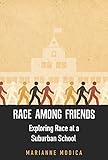Race among Friends : Exploring Race at a Suburban School / Marianne Modica.
Material type: TextSeries: Rutgers Series in Childhood StudiesPublisher: New Brunswick, NJ : Rutgers University Press, [2015]Copyright date: ©2015Description: 1 online resource (192 p.) : 1 halftone, 3 tablesContent type:
TextSeries: Rutgers Series in Childhood StudiesPublisher: New Brunswick, NJ : Rutgers University Press, [2015]Copyright date: ©2015Description: 1 online resource (192 p.) : 1 halftone, 3 tablesContent type: - 9780813573441
- 9780813573465
- 379.2/6 23
- online - DeGruyter
| Item type | Current library | Call number | URL | Status | Notes | Barcode | |
|---|---|---|---|---|---|---|---|
 eBook
eBook
|
Biblioteca "Angelicum" Pont. Univ. S.Tommaso d'Aquino Nuvola online | online - DeGruyter (Browse shelf(Opens below)) | Online access | Not for loan (Accesso limitato) | Accesso per gli utenti autorizzati / Access for authorized users | (dgr)9780813573465 |
Frontmatter -- Contents -- Acknowledgments -- Introduction: Race, Friendship, and Multicultural Literature -- 1. Boundaries among Friends: Performing Race and Policing Its Boundaries -- 2. Anger among Friends: Beneath the Surface of “We All Get Along” -- 3. Discourse among Friends: The Harlem Renaissance Unit -- 4. Resistance among Friends: The Bluest Eye -- Conclusion: “How Can We Fix This?” -- Appendix A: Studying Race in the Suburbs: More on Methods -- Appendix B: The Childist/Critical Race Approach -- Appendix C: Childist/Critical Race Lesson for 11 Honors -- Notes -- References -- Index
restricted access online access with authorization star
http://purl.org/coar/access_right/c_16ec
Many saw the 2008 election of Barack Obama as a sign that America had moved past the issue of race, that a colorblind society was finally within reach. But as Marianne Modica reveals in Race Among Friends, attempts to be colorblind do not end racism—in fact, ignoring race increases the likelihood that racism will occur in our schools and in society. This intriguing volume focuses on a “racially friendly” suburban charter school called Excellence Academy, highlighting the ways that students and teachers think about race and act out racial identity. Modica finds that even in an environment where students of all racial backgrounds work and play together harmoniously, race affects the daily experiences of students and teachers in profound but unexamined ways. Some teachers, she notes, feared that talking about race in the classroom would open them to charges of racism, so they avoided the topic. And rather than generate honest and constructive conversations about race, student friendships opened the door for insensitive racial comments by whites, resentment and silence by blacks, and racially biased administrative practices. In the end, the school’s friendly environment did not promote—and may have hindered—serious discussion of race and racial inequity. The desire to ignore race in favor of a “colorblind society,” Modica writes, has become an entrenched part of American culture. But as Race Among Friends shows, when race becomes a taboo subject, it has serious ramifications for students and teachers of all ethnic origins.
Mode of access: Internet via World Wide Web.
In English.
Description based on online resource; title from PDF title page (publisher's Web site, viewed 27. Jan 2023)


